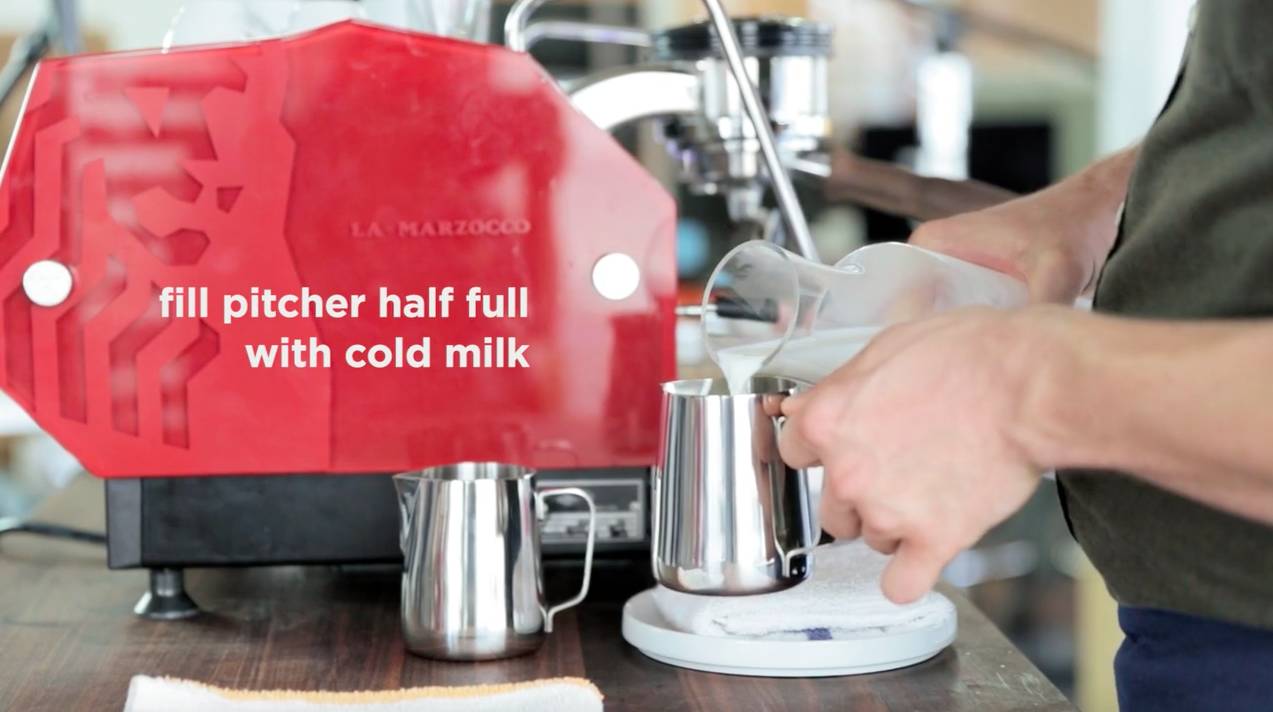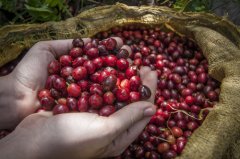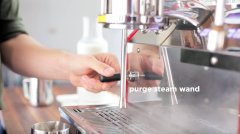Foaming skills from historical origins to milk characteristics to hand-on tutorials teach you perfect "foaming".

For professional baristas, please follow the coffee workshop (Wechat official account cafe_style)
Don't get me wrong, "bubbling" is the daily job of baristas. Whenever guests order cappuccino or latte and other espresso with milk, they have to play a dozen, but how to "bubble" perfectly? This article ranges from historical origin to milk characteristics to hand-to-hand tutorials. Please put it away and practice it slowly.)
The perfect encounter between ① espresso and milk
Espresso and milk are a perfect match. The former has fruity, caramel and chocolate flavors, while the latter is a healthy daily drink with taffy, chocolate and dried fruit flavors derived from the mixture. It's really a drink that you don't want to stop after drinking. Espresso with milk is an ideal breakfast substitute for many people, providing the calories and major minerals needed in the morning.
From sprinkling milkshakes in espresso to breaking into a cup to soften the foam or milk coat of pure espresso, espresso and milk are available in a wide range of ways. Today, most of the coffee drinks served in cafes are actually milk. To be honest, some coffee chains are increasingly adept at masking the flavor of coffee with frightening amounts of milk and extra seasonings (usually sweeteners). But then again, even in boutique cafes, milk is very important to the quality of the finished product, as a part of the drink, it is elegant and delicate, at the same time, it is an important intermediate to control the temperature of the drink.
Espresso is not the beginning of all this, let alone the end. You may not expect that humans have been mixing coffee and milk for about 300 years.
History: the close relationship between Coffee and Milk
Coffee and milk (or cream) have always been natural companions. People began to put them together as early as the 18th century. But this is not to enjoy its own taste, at the time, only children, the elderly and the sick would drink the drink. For the same reason, mixed drinks of milk and tea also sprang up at the same time. Aren't you feeling well? Put some milk in your coffee. Later, people began to add cream to the coffee, gradually creating a casual drink.
In 1727, James Douglas, a British historian, wrote that many people hated the bitterness of black coffee and preferred to "add sugar or milk to it". Tristram Shandi, the eponymous protagonist of Lawrence Stern's comedy novel published in the 1860s, is particularly fond of drinking "two cups of coffee milk", saying the drink is "worth paying for." But milk and coffee must be boiled together, otherwise coffee is still coffee, milk or milk.
Personally, I think most of the cooked milk doesn't taste good. Whether these early attempts invented latte or not remains to be seen, and the perfect combination of coffee and milk did not really arrive until the Italian coffee machine reached maturity in the mid-20th century.
There are three main reasons why milk and espresso machines are good partners. First, drinking milk in order to hydration, drinking coffee in order to absorb caffeine, both can be carried out at the same time, quite saving time. A mixture of warm milk and hot espresso can be drunk in a few mouthfuls, which is a pretty good breakfast in a cup for people who are in a hurry early in the morning. Second, milk can cool the drink more or less, especially the traditional Italian latte. In other words, you can drink a lot without having to worry too much about burning your mouth. Third, the economic benefit is good. If a bag of change can only get a cup of 25ml, just a little more caffeine and coffee flavor, no one may like it. But if you make this drink bigger, you can slowly taste it, and it will sell well. Because the time for drinking coffee has been greatly extended, coffee is no longer a fast-paced business of leaning on the bar, buying a cup and leaving. As a result, the coffee shop also found a business opportunity to sell snacks, cakes, doughnuts and other food along with the coffee. Espresso and milk drinks make everyone happy.
② various types of milk
Milk is an emulsion composed of fat spheres and mixtures of minerals, proteins, acids, sugars and salts. Whey protein and β-lactoglobulin control the fat sphere and suspend it in water, making milk a stable substance. The mixture of fat and water makes milk opaque, and the refraction of light by the emulsion makes it look blurred.
The milk you drink is almost certainly pasteurized. Pasteurization can kill 99.999% of the bacteria and prolong the shelf life of milk products from 3 days to about 3 weeks. The standard pasteurization, high-temperature short-term disinfection (HTST), quickly heats milk to 72 ℃ and lasts for 15 seconds to kill bacteria. Pasteurization, of course, has its drawbacks. It destroys part of whey protein in milk and reduces mineral content.
The milk is heated to an ultra-high 135℃ for 2 seconds by "long-lasting milk" or ultra-high temperature disinfection (UHT), and then cooled by high temperature steam jet and vacuum device. Ultra-high temperature pasteurized milk is very popular in Europe (with a big exception in the UK), but I think it is far inferior to ordinary pasteurized milk.
The milk fat in the milk was separated by microfiltration and pasteurized separately. Thin whey can pass through small pores, bacterial spores are filtered out, and then the cream is mixed in. This disinfection method is slightly less effective in cleaning up harmful bacteria, but most of the natural mineral and protein content of the milk itself is retained.
Many milk brands also need to be homogenized. When the flowing milk is baked and heated in a very fine tube, the fat molecules break down into small particles. The proteins in the milk fix these small particles and keep them in a state of emulsion. After these processes, the milk becomes silky and smooth; although it tastes worse than unhomogenized milk, it is fortunately no longer delaminated. I'm not very old, so I still remember that unhomogenized bottled milk often blocks the neck of the bottle because of the delamination of milk fat.
I've always liked to make cappuccinos, lattes and plain white coffee with whole milk. The high content of fat makes the milk look silky, smooth and dense, with an obvious taste and a more mellow taste. But that's what happens in the world, and the best food is always accused of being bad for your health. For those who are worried about fat content, they can buy skim or semi-skim milk. In order not to compromise on quality, I would rather sacrifice one or two grams of extra dietary fat.
Whole milk contains 3.25-3.5% fat and skim milk contains about 1%. A standard latte requires about 150 milliliters of milk, that is, making lattes from whole milk and skim milk with 5 grams and 1.5 grams of fat, respectively, which means a difference of 3.5 grams per serving of coffee. By analogy, a packet of 150 grams of nuts contains 70 grams of fat, which is 20 times the fat difference between full-fat and nonfat lattes. And the latest research also shows that the less milk is processed, the healthier it is, and it has nothing to do with fat content.
Some milk is naturally low-fat milk. New Zealand cows are selectively fed, so the milk directly from the breast is low-fat milk with 1% fat. The traditional belief that fat is harmful to the body and that a high-fat diet even leads to an increased risk of heart disease, but some studies disagree, arguing that the old idea is completely wrong.
Detailed explanation of the principle and steps of ③ steaming milk (dispelling milk)
Steaming milk correctly can make a good combination of tiny bubbles and warm liquids to give a sweet taste and light texture. Milk is often overheated in large coffee chains, which is really depressing. The burning taste in the coffee is a testament to overheated milk, or rather, milk tortured by the heat screams and rumbles in the flower cup. Espresso drinks with milk should not be too hot, but many stubborn coffee diners (especially in the UK) insist that their milk should reach a magmatic temperature, regardless of how much flavor is lost. The temperature of drinking milk is not only related to the perceived heat of taste, but also creative and destructive. In order to maximize the natural sweetness of the finished product, it must be strictly controlled. It is not difficult to treat the milk at the right temperature. heat no more than 70 ℃ and store in a warm cup and drink it as soon as possible.
Foam
Water and air are difficult to mix uniformly under normal conditions, and surfactants are needed to tie them together. When you beat the milk fat with a blender, the fat in the milk fat acts as a surfactant, and small bubbles and water can form a whole with the rest of the milk fat. The air injected during stirring expands the fat in the milk fat and thickens the milk fat. As the mixed structure of milk fat becomes lighter and lighter, it becomes more difficult for water to flow away.
Milk bubbles are fixed by protein (over a period of time) rather than fat, which is similar to protein-shaped protein cream. As soon as the milk is heated, the spring-like protein begins to disintegrate and denature.
Compared with milk fat and protein, the protein in milk can only barely maintain the form of foam, so the foam is usually thin, watery and easy to lose. The lost foam becomes lighter and lighter until it eventually becomes an ultra-light cobweb structure floating on the surface of the liquid. This process begins with the end of steaming milk, so after just a few minutes, the creamy cappuccino begins to delaminate and turns into a light drink with foam on top of milk and coffee on top. Many people think that this kind of cappuccino with "a layer of foam floating on top" is authentic. But I assure you, the cappuccino, which is the perfect combination of foam and coffee (that is, before it has time to "layer"), will not create an embarrassing white beard while sipping, giving you more sensory enjoyment.
As mentioned earlier, the thicker the liquid, the less you have to worry about the loss of water, so the bubbles of whole milk are much stronger than skim milk. In addition, because the fat content of skim milk is low, it does not have a strong inhibitory effect on the stability of protein foam, so it is more likely to foam.
How to dispose of milk
Milk must be kept in the refrigerator. There is no doubt that frozen milk has a longer shelf life, and it is much easier to soak with cold milk. The reason is simple: you have more time to "dispense" (inject air) milk before reaching the default temperature.
The flower cup must be clean. The specific shape and size of the flower cup depends on personal preference. According to the heat absorption law of the metal, the thicker the flower cup, the slower the heat. A clip-type temperature probe can be used to monitor the heating in the flower cup. Simple analog temperature probes are also easy to use, but I prefer infrared probes that respond quickly and provide digital readings. As long as practice makes perfect, the temperature can be grasped only by listening and observation (actually mainly by listening), and the probe will not be used.
With the controlled injection of air, the milk begins to spin and stretch violently, resulting in a force that causes tiny bubbles to break down in the milk and become suspended for a short time. Milk that is fully mixed with air is often called "microbubbles" because the bubbles are so closely integrated with the milk that they are completely invisible to the naked eye. The milk at this time looks thicker and more creamy. Never reheat the milk, or the second-heated protein will not work and the taste will get worse.
The following steps describe how to use the steam bar attached to the espresso machine to bubble the milk in the flower cup and how to heat the milk to the temperature you need.
① pour the milk into the flower cup, at least half full. Be sure not to reheat the milk, so add as much as you need.
② cleans the steam bar of the espresso machine and removes the remaining condensate.
③ ensures that the tip of the steam stick is just inserted into the milk surface and starts at full power. If the amount of milk is very small, it can be reduced slightly.
Low power.
④ begins to bubble, controlling the direction of the steam flow along the inner perimeter of the flower cup, beating the milk into a whirlpool.
⑤ increases the steam supply and pulls the tip of the steam stick to the surface of the milk. in addition to the noise of milk stirring, you should be able to hear a sharp "popping sound". No big bubbles should be seen at this time.
⑥ continues to spin the milk and bubble. Once it reaches 40 ℃, the free-flowing fat will make trouble, and the milk will be very difficult to move.
⑦ inserted the steam stick deep into the milk and kept his left hand spinning until 65 ℃
⑧ immediately turns off the steam bar.
⑨ gently tapped the flower cup to crack the foam on the surface.
⑩ rotates the milk foam quickly and vigorously in a circumferential track, so that air, water and milk are fully combined and quickly poured into the coffee.
Important Notice :
前街咖啡 FrontStreet Coffee has moved to new addredd:
FrontStreet Coffee Address: 315,Donghua East Road,GuangZhou
Tel:020 38364473
- Prev

Comparison of flavor between water-free sun treatment and sun treatment, water washing treatment and honey treatment
For the exchange of professional baristas, please follow the coffee workshop (Wechat official account cafe_style) El Naranjo Dipilto. Orange Fruit Manor (Best of Nicaragua winning Manor | Award record: 2016. 1st place) Nicaraguan Coffee non-stick Sun treatment Variety: Maragogype production area: Nueva Segovia (New Sagovia) area: Dipilto Grade: St
- Next

Why is the success rate of foaming at home so low when engineering students sum up the tricks of milking?
Communication of professional baristas Please pay attention to the coffee workshop (Wechat official account cafe_style). At first, you are interested in drawing flowers and want to learn their skills. Of course, the first lesson is to make thick and fine milk bubbles. Unfortunately, I really don't know what is thick and meticulous enough that I haven't seen it with my own eyes. Fortunately, it's not a problem. Just take a trip to Starbucks or Imando.
Related
- What is the meaning of lactic acid fermentation with coffee bean treatment?
- How to judge the state of foam by sound?
- How does the latte pull out the unicorn pattern? Come to get for a little trick to improve the flower pull!
- Will flower pulling affect the taste of the latte?
- Do you know the history of coffee?
- The difference between honey treatment and sun washing what is raisin honey treatment?
- What kind of milk can a novice use to make coffee foam to keep the foam longer? The correct method and skills of milking tutorial sharing
- Why do washed coffee beans taste sour? Flavor characteristics of washed Coffee
- Introduction to the skill of how to practice the size and height of water injection around the circle of hand-brewed coffee
- How do beginners practice coffee flower drawing from scratch?

